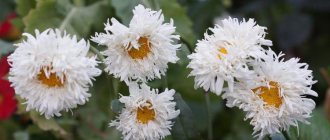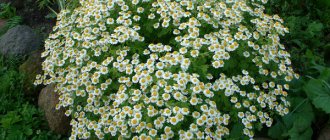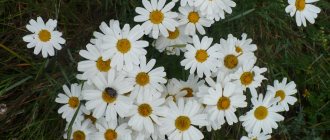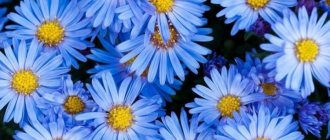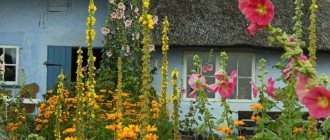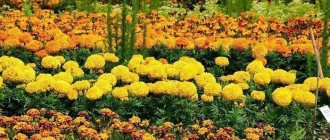Chamomile is a flower that can be kept in almost every garden plot. They love it for its variety of colors, ease of care, and decoration of landscape design. It belongs to the Astrov family. Large daisies, depending on the variety, can grow up to 1 meter in height. The stem is strong, rich green, slightly rough. The leaves growing along the length of the stem have a smooth texture, glossy, with dark green veins. The petals are arranged in several rows around a yellow center. The flower itself can reach 15 cm in diameter. The plant pleases the gardener with long-lasting flowering. It begins in the first ten days of June, and ends in the last ten days of September.
Chamomile is a plant that has grown exclusively in the wild for a very long time. Only 200 years ago did gardeners become interested in it for growing in gardens and personal plots. From the moment garden chamomile became widespread among flower growers, breeders began working on creating new varieties. Today there are a huge number of varieties of this already decorative plant. All varieties have many common features.
Ornamental varieties have already surpassed their wild relatives in terms of performance. They have a larger flower diameter, are taller, have a variety of colors, etc. But chamomile cannot be confused with another flower. Its middle consists of small tubular flowers, and along the diameter of the central part there are false-ligulate petals.
There are many more flowers that belong to the Asteraceae family. They are somewhat similar to each other. What are the names of flowers that look like large daisies? For example, gerberas. The name itself, large daisies, means Roman. The scientific name of this flower, derived from the Latin matrix, means uterus.
Botanical description
The name of the flower in Latin is “Camomille Matricaria”, the family to which chamomile belongs is Asteraceae or Asteraceae, class Dicotyledons. Common Chamomile has the following botanical description:
- stem - straight, branches into several branches at the base, stem height 15-50 cm;
- the root system is taproot, penetration depth into the soil is up to 50 cm;
- the leaves are lanceolate-shaped, divided into lobes, the color of the leaf blades varies from light tones to richly dark shades of green;
- inflorescences are represented by a hemispherical basket, the receptacle is conical;
- the baskets are composed of false-lingulate flowers of yellow and white color;
- The fruit of the plant is an oblong achene with no tuft.
Chamomile is a perennial plant, native to South Africa, Eurasia and America.
The Latin name "Matricaria", which translates as "uterus", was given to chamomile because it was used to treat diseases of the female reproductive system, especially to treat pathologies of the uterus.
Differences between true daisies and others
The main sign by which chamomile is recognized is the structure of its inflorescences and the combination of colors. Most species are characterized by the presence of small yellow tubular flowers located in the center and white reed flowers surrounding them along the outer contour. That is, in reality, chamomile is not one flower, but an inflorescence consisting of many small individual flowers. What are commonly called “stamens” of a chamomile are actually flowers, and what are called “petals” are also separate flowers, but of a different shape.
Green and golden chamomile do not have white edge flowers, but they also belong to the genus Matricaria. At the same time, plants whose inflorescence structure is very similar to that of daisies, but contain other color combinations, for example, yellow and red, pink, belong to other genera.
As mentioned above, all species of the genus Matricaria have a cavity in the receptacle, which increases in size as the inflorescence matures and fades.
Another important feature that allows you to distinguish a representative of the genus Matricaria from other plants is the raised core, which is scientifically called the receptacle. At the beginning of the season, it is slightly curved, but the white flowers are still somewhat lower than the yellow ones. This can be clearly seen in the photo:
By the time the seeds ripen, the receptacle takes on an almost conical shape:
You need to collect chamomile during the flowering period, before it begins to fade and produce seeds. Since different bushes in the same area bloom for several months, it is impossible to determine the most suitable period for collection. Whether a plant is suitable for harvesting can be determined by its type. If the white marginal flowers are in a horizontal position, then the concentration of essential oil and nutrients in the inflorescence is maximum. White flowers drooping down indicate the withering of the plant and, accordingly, a weakening of its beneficial properties.
Distinctive features can also be noticed by looking closely at the leaves, stems and structure of daisy bushes. Most species have several stems with single flower heads on each, and the leaves are usually small, pinnately dissected. The height of the stems may vary among different species. For example, in the green and golden matricaria it reaches only 25-30 cm, and in the medicinal one - 60 cm. Also, the bushes of the latter are not dense, and weeds can grow through them. At the same time, the navel, which is similar to it, or as it is also called Roman daisy, has larger leaves, and the bushes are correspondingly dense.
Flower varieties
There are more than 300 varieties of chamomile, but the most famous are the following types:
- cornflower;
- echinacea;
- autumn helenium;
- gaillardia spinosa;
- doronicum yellow;
- small petal.
Other varieties of the flower are Persian, Caucasian, German, Roman. Unlike wild daisies, decorative varieties of the flower are characterized by color diversity. Varietal daisies can be red, yellow and blue, lilac and orange. The height of their stem reaches from 60 to 100 cm.
What kind of daisies there are depends on their variety; they are not only white, but also red, yellow, purple
Varietal diversity
Bush perennial chamomile has about 25 species of different flowers, the most popular are the following varieties:
- Alaska - inflorescences are about 10 cm in diameter, snow-white petals and a rich yellow center. The height of the bush is from 60 to 80 cm.
- Princess - flower diameter is 8 cm, height is small - up to 30 cm, due to which it is recommended to grow it along borders as a frame for flower beds. Flowering is short - about 1 month. It is a large white daisy with a yellow center.
- The northern star is one of the largest flowers, with a diameter of about 16 cm. The height of the bush is about 50 cm. A distinctive feature is the pointed ends of the petals, like an aster.
- The perennial daisy is a white flower with oblong-shaped petals, at the end of which there are several small teeth. The inflorescence size is about 7 cm.
Perennial leucanthemum (lat. Leucanthemum) is a plant of the Asteraceae family, which does not belong to the classic daisies.
There is a wide variety of subspecies of garden plants with large inflorescences; they differ in the shape and number of petals.
Large colored daisies:
- Persian or Pyrethrum - stem height is from 50 cm to 1 m, the color of the petals is red. Hybrid varieties can be yellow, burgundy and pink. Flowers on stems last all summer.
- Erigeron - the diameter of the baskets is about 5 cm, the height of the stem is up to 80 cm. The plant is distinguished by a variety of colors - the petals can be lilac, red and blue, violet. Opening in early summer, these large daisies retain their beauty until September.
- Doronicum is the name of large bright yellow daisies with openwork-shaped petals. The advantage of Doronicum for a gardener is the ability to grow it in any soil, both in the shade and in well-lit areas.
- Orange small-petaled petals are narrow in shape and rich orange in color.
- Blue large-flowered chamomile - bush height 60 cm. A distinctive feature is the blue color of the petals.
Blue perennial is known for making essential oil, widely used in cosmetology.
Specimens with colored petals are especially beautiful and unusual; they are a real pearl of any garden.
Landing - rules and features
Planting a flower can be done either by seedlings or through seeds. The seedling method is preferred as it is more reliable.
With the seed method, seeds can be planted directly in open ground.
Rules and features of chamomile seedling planting:
- Planting time is March.
- Preparing seeds - 3 weeks - 1 month before planting in the ground, the seeds are placed in the refrigerator on the bottom shelf. Stratification will make the planting material stronger, reducing its sensitivity to diseases and pests.
- Containers - a tray divided into cells.
- The soil is light, containing 1 part sand and peat.
- Several seeds are dropped into one cell.
- The seeds are covered with a thin layer of nutritious soil mixture on top.
- The container is covered with a loose, transparent film and placed near the windowsill.
- The soil is moistened from the sprayer as it dries.
It is better to immediately plant chamomile in separate containers.
It is recommended to immediately place the seedlings in separate containers, so as not to have to thin them later, as there is a risk of damage to the root system.
You cannot place a container with seeds directly on the windowsill. When exposed to direct sunlight, seeds will germinate less easily and young shoots may develop sunburn.
Instructions for caring for planted seeds and seedlings:
- At room temperature, the first seedlings will appear in about 2 weeks.
- Immediately after the sprouts appear, the film is removed from the container and the container is placed in a well-lit place, the main thing is that there are no drafts there.
- If it is not possible to provide abundant sunlight, you can use fluorescent lamps. Daylight hours are 14 hours.
- Thinning of seedlings occurs when seedlings reach 5 cm in height. The essence of thinning is to leave only one, the strongest seedling in each cell.
- To make the seedlings more spread out, pinching is done over the 3rd leaf plate, this will promote the growth of lateral stems.
When thinning, seedlings should not be pulled out of the ground, as this can damage the roots of neighboring shoots. It is recommended to break off the seedling above the soil.
Growing a flower and further caring for it
Chamomile flowers are transplanted into open ground no earlier than 30-45 days after emergence. A prerequisite for transplantation is the absence of frost.
To plant chamomile flowers, you need to choose a well-lit area, without drafts. Suitable soil is limestone or neutral. Groundwater must lie deep.
The description of field chamomile speaks of the unpretentiousness of the flower, and therefore it can be planted not only in the ground, but also left in a pot
Planting a chamomile flower in open ground:
- Preparing the site includes digging it up and applying complex fertilizer intended for flowers.
- The depth of the holes is from 20 to 30 cm. The distance between the holes is at least 40 cm.
- The seedlings are taken out of the container with a lump of earth on the roots, carefully moved into the prepared holes, and covered with earth on top.
- The soil is lightly compacted and watered.
The depth of the holes and the distance between them must be selected depending on the type of flower.
When daisies grow, they need to be provided with proper care, which includes the following factors:
- Watering is systematic for the first 2-3 weeks, until the daisies take root. You cannot overfill the soil. The frequency of watering depends on how quickly the soil dries out. When the daisies take root, watering is reduced and is carried out only during prolonged drought.
- Mulching - carried out after watering, the recommended material is peat.
- Loosening the soil is a mandatory procedure and is performed after each watering.
- Fertilizer - applied every year. The nutrient substrate consists of peat, humus and compost, which are mixed with the soil. In the spring, ammonium nitrate is scattered under each bush in a dosage of 20 grams per 1 m².
- During the formation of buds, under flowers that are distinguished by lethargy and pale leaf blades, it is recommended to apply a urea solution.
- In autumn, slaked lime or dolomite flour is added to highly acidic soil.
After applying saltpeter under the bush, there is no need to water the plant.
The bushes must be prepared for wintering, because what is chamomile? It is a heat-loving flower. Before the onset of frost, the above-ground part of the bushes is completely cut off, then they are covered with dry leaves or sawdust.
In regions with severe frosts, it is recommended to cover daisies with non-woven materials.
Spreading
You can meet wild representatives of the family on almost every continent. The plant is actively developing throughout the European part, America and southern regions of Africa. The crop is grown in Asian countries and Australia. Most often, wild-growing ones are represented by such varieties as: pharmaceutical, fragrant or peeled chamomile.
In Russia, chamomile is found almost throughout the temperate climate zone. In the middle zone it grows along roads, in meadows and near houses. In some regions it is a weed that is difficult to remove. In some areas it is cultivated as a medicinal raw material.
Reproduction methods
Decorative daisies reproduce in two ways - by seeds and by dividing the bush.
Bush dividing method:
- The procedure is carried out at the end of September - the first week of October, always on a cool and cloudy day.
- One part with the root system is separated from the mother bush and transplanted into a previously prepared hole. Before planting, the hole is watered with settled or rainwater. Side shoots should be cut with a clean, disinfected tool.
- The hole with the cut part is filled with a nutritious soil mixture, which is then lightly compacted.
When propagating by division, only the healthy, young and strongest shoots are cut off. Next year, shoots from the opposite side will need to be cut off from the same mother bush.
Growing daisies in the same place is allowed for no more than 5 years, then the location for the flowers needs to be changed, otherwise they will begin to weaken and may stop blooming.
Propagation of a flower by seed means the correct collection of seed material, with its further use for seedlings:
- Seeds are collected from completely dried flowers. The flowers are cut and left in a dry place with good ventilation.
- The seed material is contained in tubular flowers, from which it is hatched when the daisies are completely dry.
- The seeds are winnowed and stored in a paper bag.
The use of collected seeds for seedlings is possible for several years. Seeds can be immediately planted in open ground.
Sometimes chamomile is planted before winter
Planting can be done even before winter - the seed will not freeze, but on the contrary, it will undergo stratification, making future plants stronger.
Only ordinary chamomiles can be propagated by seeds. Varietal and double representatives of the plant do not retain parental characteristics in the seeds.
Diseases and pests - methods of combating them
Diseases to which chamomiles are susceptible if not properly cared for:
- Fusarium is a fungus that causes root rot. Signs - tissues become brown, shoots become thinner and weaker.
- Powdery mildew is the appearance of a white coating on a flower, which gradually becomes brown.
- Gray rot is the formation of brown spots on leaf blades that rapidly increase in size. Gradually, the leaf part of the plant turns completely yellow.
- Rust is the appearance of dark yellow, dense spots on the foliage.
To treat chamomile diseases, fungicides are used - Kuproxat, Oxychom, Fundazol.
Preventing the occurrence of diseases - following the rules of watering, without waterlogging the soil, timely loosening the soil and weeding.
Insects:
- thrips, aphids - the appearance of light yellow spots on the leaf blades, the gradual death of the soft tissues of the plant;
- wireworms - damage the root system, leading to the death of the entire bush;
- star-winged fly - accumulates on the middle flowers, sucking the juices from the plant.
Insecticides are used to get rid of insects. Measures to prevent the appearance of parasites include proper plant care, timely removal of weeds, preventive treatment with insecticides, otherwise the flower will not be able to grow strong and beautiful.
Diseases must be combated immediately when the first signs appear, otherwise the chamomile bush will quickly die
Advice from flower growers
- For propagation, it is better to choose a double variety of garden chamomile, since the flowers are larger and more beautiful, there are always many buds, and re-blooming is possible at the end of summer.
- Despite its frost resistance and hardiness, the flower can freeze in a winter with little snow, so it is sprinkled with a thick layer of peat, straw, and covered with spruce branches.
- Chamomile gets along well with any ornamental plant: with the beautiful lily and rose, field poppy and cornflower.
- In the search engine results for the query “garden chamomile, large perennial planting and care,” sometimes there are articles devoted to chamomile, which is a related, but still completely different medicinal wild plant. The technology of its cultivation and use differs from decorative chamomile. Therefore, you should carefully read the text of the article to determine what type of chamomile (decorative or medicinal) we are talking about.
Garden chamomile is considered not only an adornment to any landscape design, but in many ways it brings love and good luck to the house, where household members begin to live in peace and harmony. Combining well in height and size with other flower crops, it fits harmoniously into any flower garden, giving it a unique and eye-catching appearance.
1 1 vote
Article rating
Useful properties of the plant, contraindications for use
Chamomile has a number of beneficial properties, which is why it has long been used not only as a traditional medicine, but also as a natural component of many medicines.
Medicinal effects of the plant:
- choleretic;
- hemostatic;
- anti-inflammatory;
- antibacterial;
- diuretic;
- soothing;
- antispasmodic.
Chamomile flowers contain tannins, macro- and microelements, vitamins, so simple tea made from it has a beneficial effect on the immune system, strengthening the body's defenses.
Taking chamomile has contraindications:
- stomach ulcer;
- acute diseases of the genitourinary system;
- psychical deviations;
- frequent diarrhea.
There may be an allergic reaction to chamomile and its chemical components caused by individual intolerance.
Decorative flowers, also called daisies
Various decorative and indoor flowers of the same Asteraceae family are often called daisies. It is usually quite easy to distinguish them from Matricaria species. Many of them have large inflorescences or flowers of a wide variety of colors: yellow, orange, red, pink, blue and others. We remember that in true daisies the inner part of the flower can only be yellow, and the outer flowers can only be white.
Australian daisies are annual plants of the genus Helipterum. They were brought to European countries, as the name suggests, from Australia. The inflorescences of Helipterums are usually single, large and very bright. Here's what some of them look like:
Alpine chamomile is the name given to the species of asters of the same name. These are annual plants that can be planted in gardens and homestead areas. They are easy to care for, but very beautiful. Dense bushes with single inflorescences retain their attractiveness until frost.
African daisies are the names given to indoor gazania and osteospermum species. They have large inflorescences and very bright flower colors. Some perennial species are grown at home in flowerpots. This is what some of them look like:
They are also called daisies and chrysanthemums, especially the Chamomile and Bacardi species. Thanks to their tall stems and large inflorescences, they are used to form bouquets.
These yellow chrysanthemums are also often called daisies:
Gerberas are sometimes called this way:
In general, to say that calling different plants daisies is a mistake would be too reckless. In common parlance, the term chamomile does not have such a strict meaning as in the scientific community; here this word is usually understood as an inflorescence of a specific shape. Therefore, for a person not immersed in science, the ability to distinguish true daisies from other flowers of the Asteraceae family may only be required when collecting the plant as a medicinal raw material. In order not to accidentally collect inflorescences of little use, you must first make sure that the collector is looking at chamomile, and it is for this that the difference between the species must be understood and be able to detect.
Usage
The main areas of use of chamomile are cosmetology and medicine. In medicine, the flower is used in the following cases:
- menstrual irregularities;
- flatulence;
- spasms;
- internal inflammatory processes;
- dermatological diseases.
Chamomile disinfects and has a disinfectant; it is added to baths for bathing babies.
Decoctions and lotions based on the plant are used in cosmetology as restorative agents for hair, for wiping the skin with acne, inflammation and acne.

